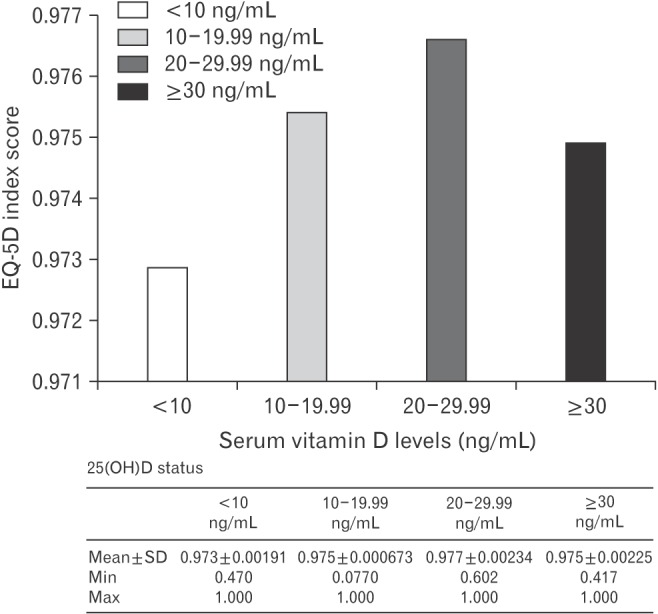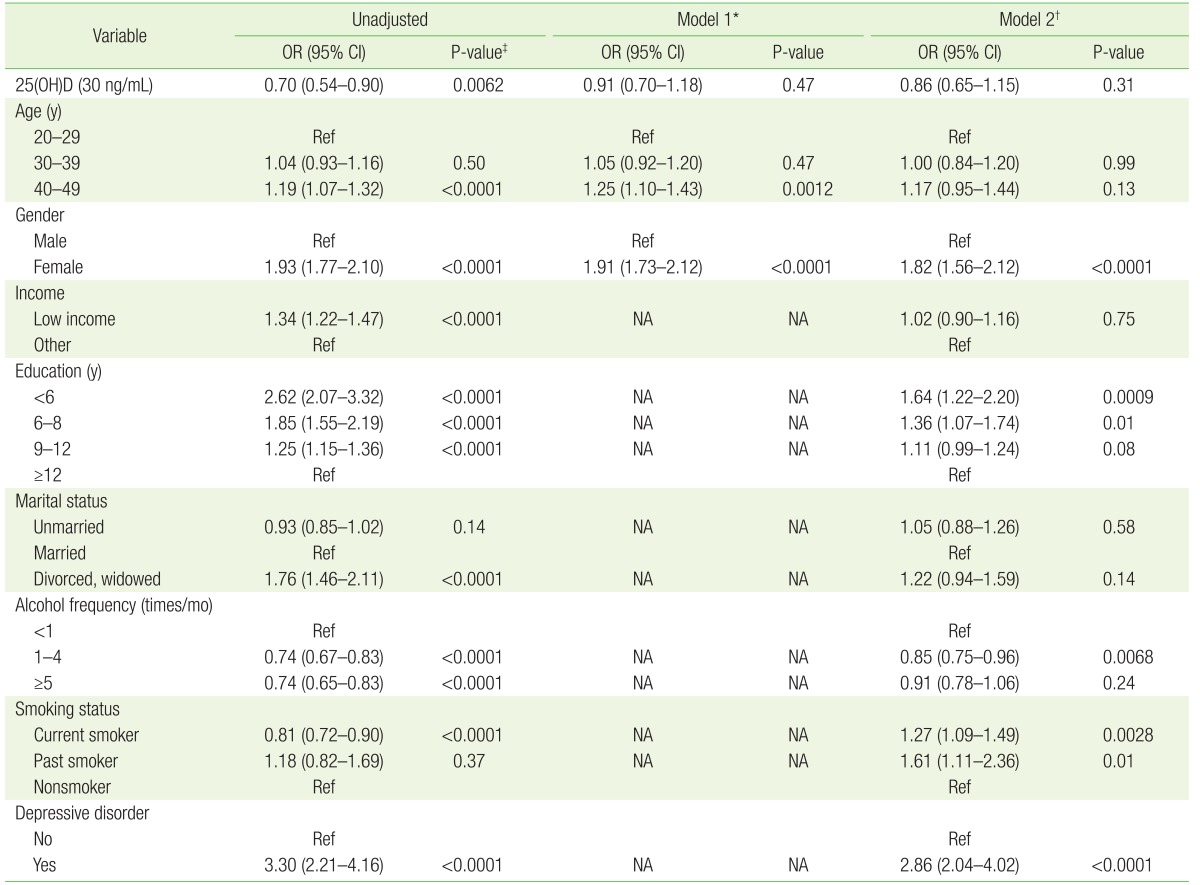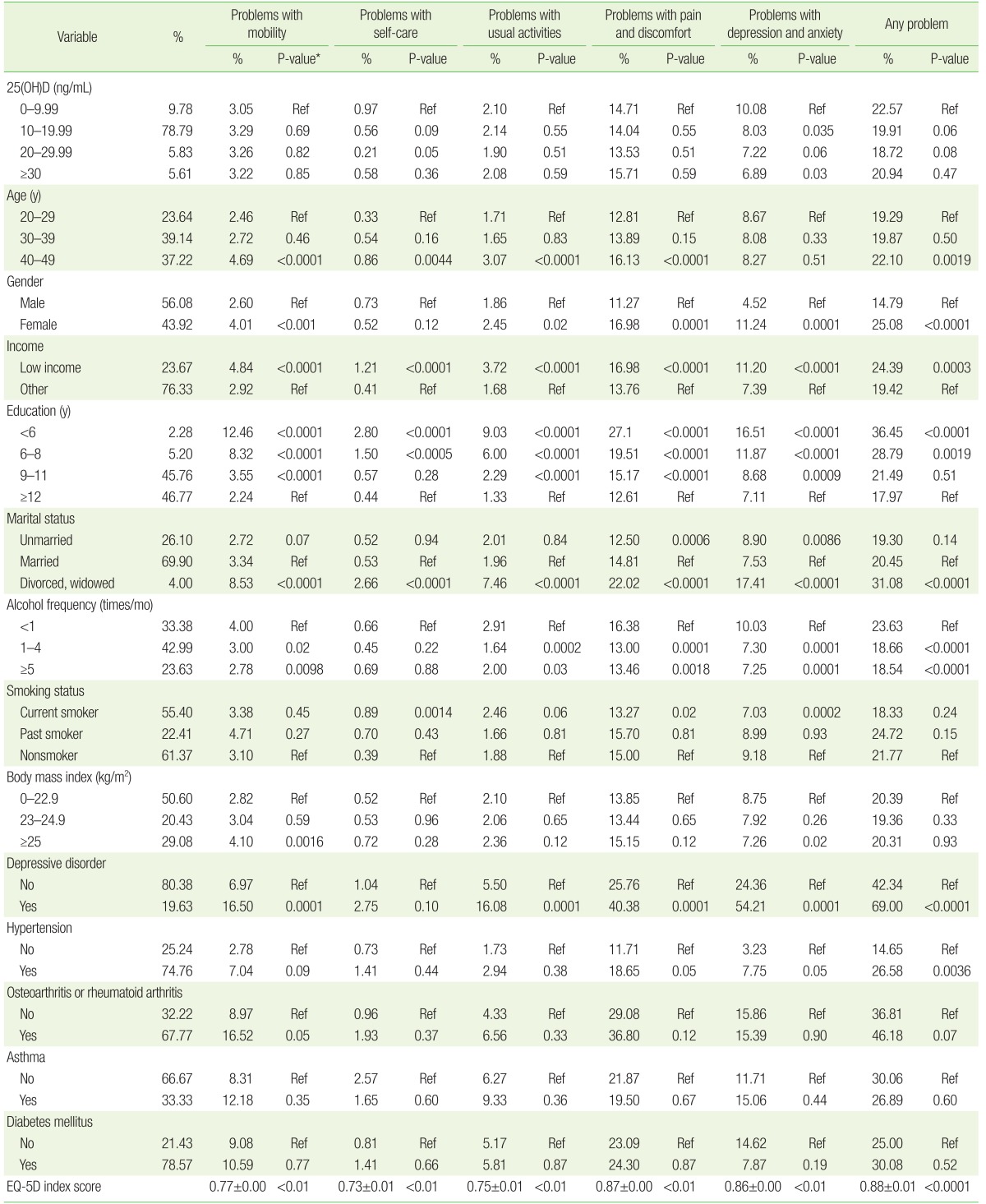1. Bouillon R, Vitamin D. from photo-synthesis, metabolism, and action to clinical applications. In: De Groot LJ, Jameson JL, editors. Endocrinology. 4th ed. Philadelphia (PA): W.B. Saunders; 2001. p. 1009-1028.
2. Rizzoli R, Eisman JA, Norquist J, Ljunggren O, Krishnarajah G, Lim SK, et al. Risk factors for vitamin D inadequacy among women with osteoporosis: an international epidemiological study. Int J Clin Pract 2006;60:1013-1019. PMID:
16893446.


3. Choi HS, Oh HJ, Choi H, Choi WH, Kim JG, Kim KM, et al. Vitamin D insufficiency in Korea: a greater threat to younger generation: the Korea National Health and Nutrition Examination Survey (KNHANES) 2008. J Clin Endocrinol Metab 2011;96:643-651. PMID:
21190984.



4. Ross AC, Manson JE, Abrams SA, Aloia JF, Brannon PM, Clinton SK, et al. The 2011 report on dietary reference intakes for calcium and vitamin D from the Institute of Medicine: what clinicians need to know. J Clin Endocrinol Metab 2011;96:53-58. PMID:
21118827.


5. Holick MF. Vitamin D deficiency. N Engl J Med 2007;357:266-281. PMID:
17634462.


6. Kerr GS, Sabahi I, Richards JS, Caplan L, Cannon GW, Reimold A, et al. Prevalence of vitamin D insufficiency/deficiency in rheumatoid arthritis and associations with disease severity and activity. J Rheumatol 2011;38:53-59. PMID:
20952475.


9. Huang W, Shah S, Long Q, Crankshaw AK, Tangpricha V. Improvement of pain, sleep, and quality of life in chronic pain patients with vitamin D supplementation. Clin J Pain 2013;29:341-347. PMID:
22699141.


10. Lee HJ, Lee HD, Hwang HS, Park HK, Kim SE. Serum vitamin D level and mean hours of sleep. Korean J Fam Pract 2014;4:293-298.
11. Kim HM, Lee JY, Chung JY, Lee DC. Serum 25-hydroxyvitamin D and DHEA-S level are associated with depression in community-dwelling older women: surveyed in one season. Korean J Clin Geri 2010;11:332-340.
12. Holick MF. Vitamin D status: measurement, interpretation, and clinical application. Ann Epidemiol 2009;19:73-78. PMID:
18329892.


13. Korea Centers for Disease Control and Prevention. EQ-5D Korean valuation study using time trade-off method. Cheongju: Korea Centers for Disease Control and Prevention; 2007.
14. Holick MF. Resurrection of vitamin D deficiency and rickets. J Clin Invest 2006;116:2062-2072. PMID:
16886050.



15. Holick MF. High prevalence of vitamin D inadequacy and implications for health. Mayo Clin Proc 2006;81:353-373. PMID:
16529140.


16. Bischoff-Ferrari HA, Giovannucci E, Willett WC, Dietrich T, Dawson-Hughes B. Estimation of optimal serum concentrations of 25-hydroxyvitamin D for multiple health outcomes. Am J Clin Nutr 2006;84:18-28. PMID:
16825677.



17. Pettifor JM. Vitamin D deficiency and nutritional rickets in children in vitamin D. In: Feldman D, Pike JW, Glorieux FH, editors. Vitamin D. 2nd ed. Boston (MA): Elsevier Academic Press; 2005. p. 1065-1084.
18. Zhu K, Austin N, Devine A, Bruce D, Prince RL. A randomized controlled trial of the effects of vitamin D on muscle strength and mobility in older women with vitamin D insufficiency. J Am Geriatr Soc 2010;58:2063-2068. PMID:
21054285.


19. Broe KE, Chen TC, Weinberg J, Bischoff-Ferrari HA, Holick MF, Kiel DP. A higher dose of vitamin d reduces the risk of falls in nursing home residents: a randomized, multiple-dose study. J Am Geriatr Soc 2007;55:234-239. PMID:
17302660.


20. Glover TL, Goodin BR, Horgas AL, Kindler LL, King CD, Sibille KT, et al. Vitamin D, race, and experimental pain sensitivity in older adults with knee osteoarthritis. Arthritis Rheum 2012;64:3926-3935. PMID:
23135697.



21. Glover TL, Goodin BR, King CD, Sibille KT, Herbert MS, Sotolongo AS, et al. A cross-sectional examination of vitamin D, obesity, and measures of pain and function in middle-aged and older adults with knee osteoarthritis. Clin J Pain 2015;31:1060-1067. PMID:
25569220.



22. Gur EB, Gokduman A, Turan GA, Tatar S, Hepyilmaz I, Zengin EB, et al. Mid-pregnancy vitamin D levels and postpartum depression. Eur J Obstet Gynecol Reprod Biol 2014;179:110-116. PMID:
24965990.


23. Farrington E, Moller M. Relationship of vitamin D3 deficiency to depression in older adults: a systematic review of the literature from 2008-2013. J Nurse Pract 2013;9:506-515.














